You’ve seen it time and time again: well-laid plans for change initiatives go by the wayside despite the best intentions.
The amount of money and emotional drain that failed change initiatives cause irreparable damage to your company’s profits, culture, and reputation.
If this is you, it’s time to overcome the seven common barriers to change through excellent change management.
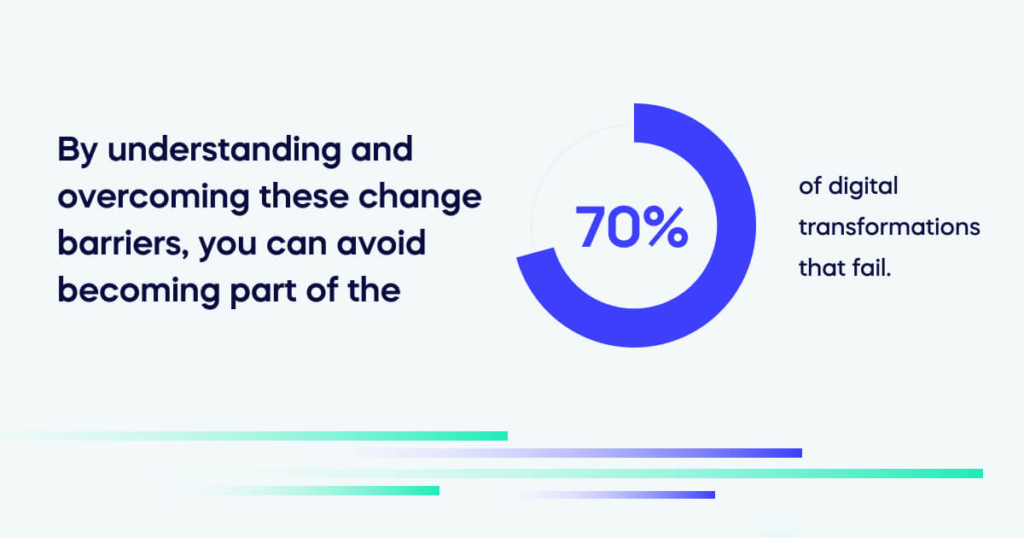
By understanding and overcoming these change barriers, you can avoid becoming part of the 70% of digital transformations that fail.
To help you overcome the six common barriers to change, we will explore the following topics:
- Why are barriers to change important?
- 7 most common barriers to change
- How to overcome the 7 common barriers to Change
Why are barriers to change important?
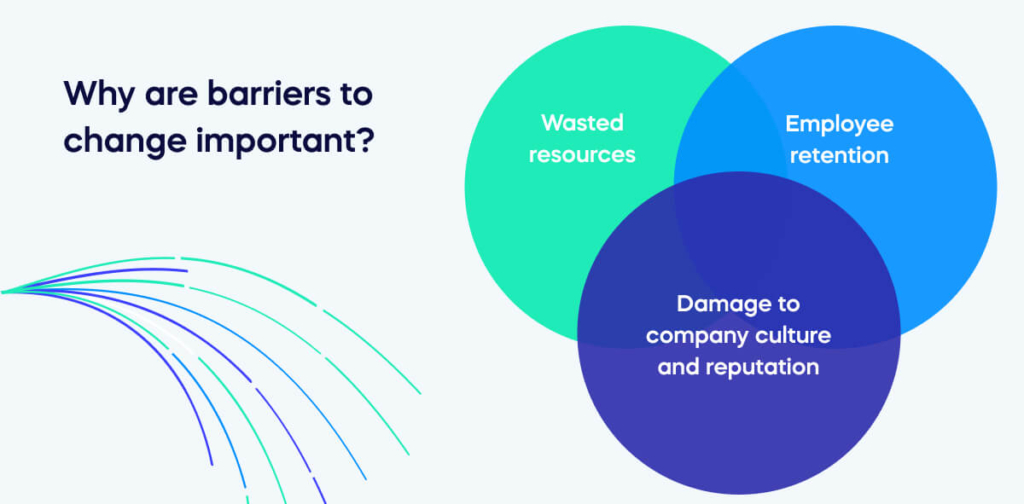
There are many reasons why barriers to change are essential to consider. The first of which involves wasted resources of organizational change.
- Wasted resources: Change involves vast amounts of resources, and if you don’t address barriers to successful change, you will waste money and time.
- Employee retention: Change causes burnout and reduces employee retention when leaders do not implement it successfully.
- Damage to company culture and reputation: If a company repeatedly fails to change initiatives, shareholders will perceive it negatively and lose investment opportunities.
Consider why barriers to change are essential to ensure you understand and overcome the barriers effectively within a robust change management strategy.
7 most common barriers to change
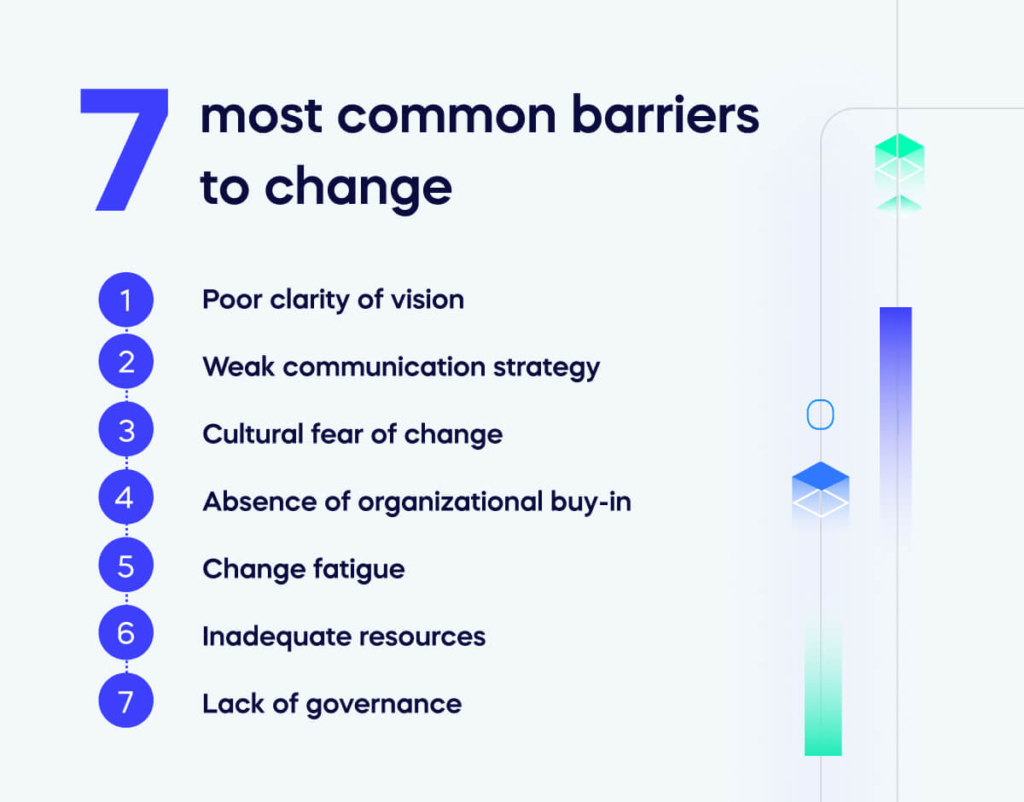
There are seven common barriers to change that you can consider and understand deeply to overcome for a digital transformation that changes your organization positively forever for future success.
1. Poor clarity of vision
Poor clarity of vision is one of the most common barriers to change.
Organizations, on average, initiated over 3 changes in the past 5 years. In the next 3 years, 75% plan increased change investments, yet only 34% are likely to materialize.
Uncertainty breeds fear in employees unaware of change benefits, so it’s crucial to communicate these advantages to regional and departmental heads, shaping teams for efficient business processes.
A change chart detailing current, transition, and future states clarifies expectations, reduces confusion, and fosters collaboration.
2. Weak communication strategy
In sales, R&D, customer support, management, or change management, a weak communication strategy is one of the most common barriers to change.
A poor communication strategy often drags other parts of the change approach down in a well-structured enterprise due to silos and bureaucracy. Large organizations face challenges in communicating numerous change projects.
Hiring many communication managers isn’t practical. A better approach is developing an effective communication strategy and empowering managers at all levels.
Invest in tools like Digital Adoption Platforms for communication beyond traditional means. These platforms facilitate learning about changes within the platform itself.
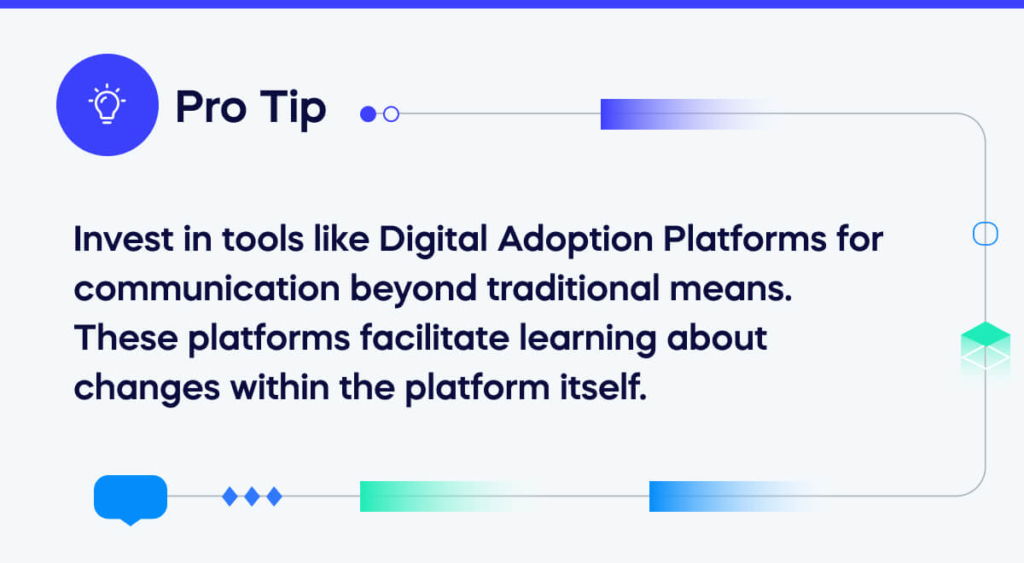
Consistently implementing these small measures ensures the communicated message remains clear and unaltered as it moves from top to bottom.
3. Cultural fear of change
A fear of change is natural in our human evolution as a response to threats. Still, when ingrained into your company culture, it becomes a barrier to innovation and digital transformation projects.
This fear is deeply ingrained, leading to a reluctance to embrace new ideas or methodologies.
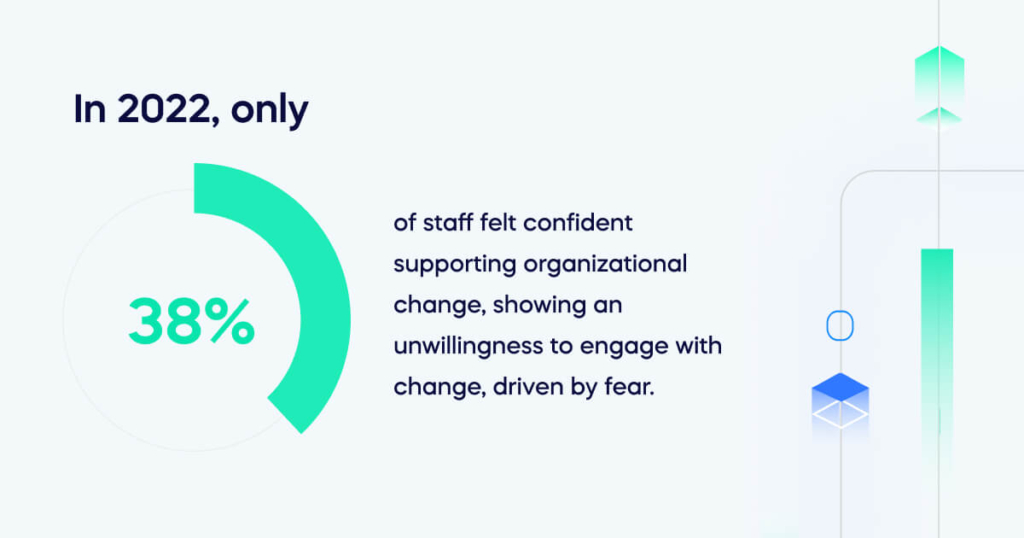
In 2022, only 38% of staff felt confident supporting organizational change, showing an unwillingness to engage with change, driven by fear.
Breaking free from this cultural inertia requires strategic leadership and a comprehensive shift in mindset.
You must foster an environment where change is viewed not as a threat but as an opportunity for growth and progress.
Doing so will ensure you alter the status quo for the long term with an in-depth understanding of how to confront a cultural fear of change, encouraging innovation.
4. Absence of organizational buy-in
Achieving a successful change initiative requires gaining support from both top management and entry-level employees. Top management buy-in is crucial to lend legitimacy to the initiative.
Their role goes beyond mere sponsorship; they must actively assume responsibility for the change and lead by example, increasing employee productivity by reducing change resistance.
Simultaneously, mid-level and entry-level employees must also align with the initiative to effectively implement the change on the ground level.
5. Change fatigue
Organizations frequently juggle numerous change projects concurrently in the implementation phase without considering external factors.
Simultaneous organizational changes overwhelm employees, leading to change fatigue. This fatigue materializes as burnout, apathy, and frustration, reducing employee engagement and productivity.
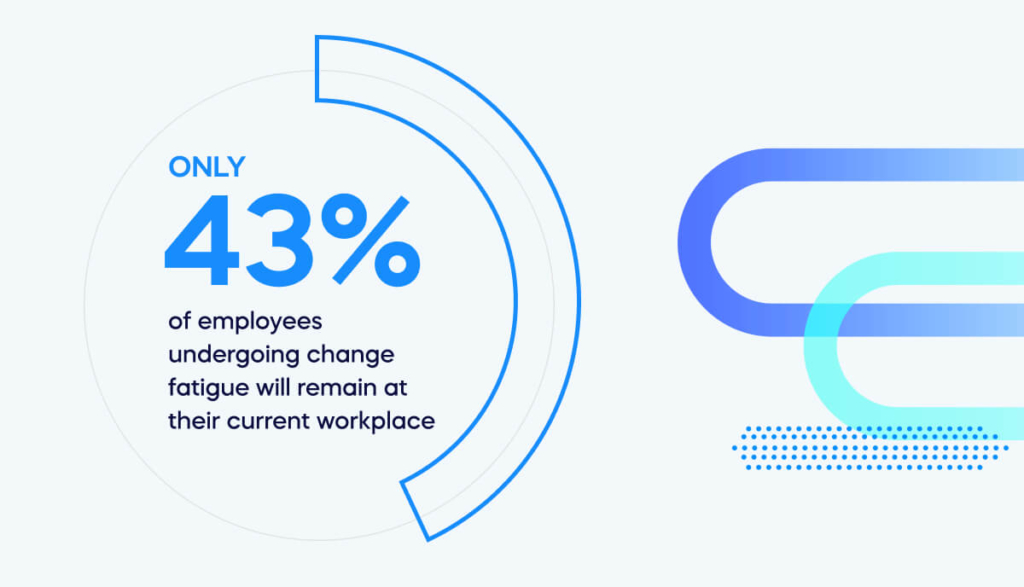
Only 43% of employees undergoing change fatigue will remain at their current workplace (cited above), showing that the impact of change fatigue can lead to employees departing, delaying change progress.
Effectively addressing this barrier to change necessitates prioritizing change management.
6. Inadequate resources
Insufficient resources pose a substantial barrier to change within organizations.
Implementing change initiatives becomes a daunting challenge when essential elements like financial, technological, or human resources are lacking.
This scarcity impedes the organization’s capacity to invest in new technologies, provide adequate training, or allocate manpower effectively.
The result is a stunted change process marked by delays, compromised quality, and frustrated stakeholders.
Overcoming this barrier demands strategic resource allocation, emphasizing the need for comprehensive planning and investment to equip the organization with the tools and manpower essential for navigating transformative changes successfully.
7. Lack of governance
Embracing change involves significant costs, and this obstacle can impose financial burdens on your organization.
Achieving successful transformative change necessitates an effective governance structure, managing the process at both micro and macro levels.
Opting for the accelerated implementation methodology is recommended for disciplined program management.
This approach ensures scalability for projects of varying sizes and complexities, whether they involve operational adjustments or profound transformational shifts.
Look out for all these barriers to change in your organization to tackle them effectively, ensuring every change project is successful.
How to overcome the 7 common barriers to change
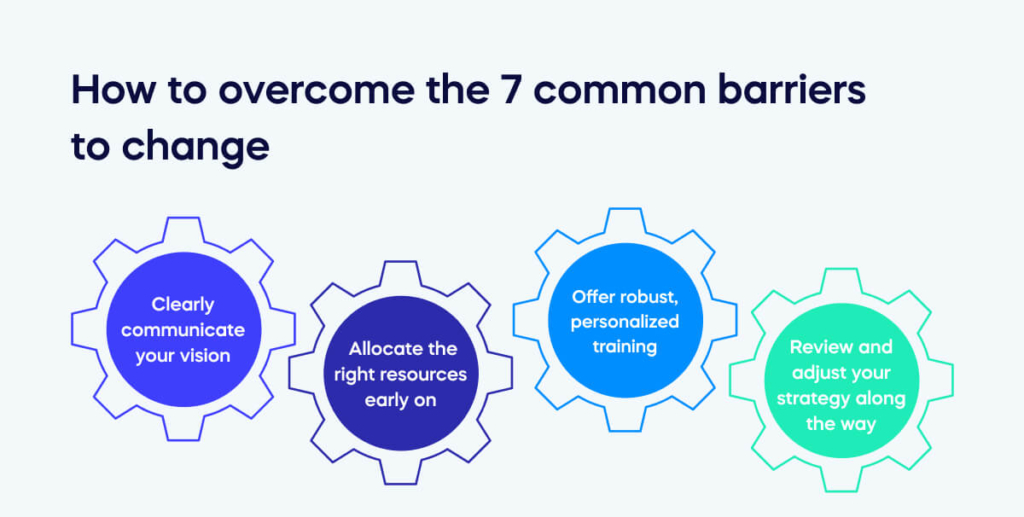
Trying to overcome the seven common barriers to change can feel overwhelming, but following the steps below can lead you to success.
The first strategy to overcome the barriers to change is to communicate your vision.
A. Clearly communicate your vision
To overcome barriers to change, articulate your vision with utmost clarity. Effective communication is pivotal in navigating resistance and fostering understanding in successful change initiatives.
Convey the purpose, benefits, and the path ahead. When the vision is transparent, it serves as a guiding light, aligning individuals and teams toward a shared goal.
This communication not only dissolves uncertainty but inspires confidence, making the journey through change more cohesive and manageable.
If unsure how to make one, check out a communication strategy template as a guide.
B. Allocate the right resources early on
Overcoming barriers to change begins with strategic resource allocation from the outset to implement successful change management strategies.
Identify and allocate the necessary resources from the following categories:
- Human.
- Financial.
- Technological.
Doing so will ensure a smooth change process.
Early planning and investment lay the foundation for success, preventing hurdles such as delays and compromised quality.
Adequate resources empower the organization to navigate change effectively, fostering a transformative journey with minimal roadblocks.
C. Offer robust, personalized training
To surmount barriers to change, provide tailored training through a digital adoption platform. Personalized guidance ensures employees grasp new processes seamlessly, reducing resistance and enhancing efficiency for any major change initiative.
These platforms go beyond conventional training methods, fostering a user-friendly approach accessible to all.
Incorporating interactive and adaptive learning empowers individuals to adapt to changes confidently.
Investing in such training tools is an effective strategy for overcoming obstacles and ensuring a successful organizational transition.
D. Review and adjust your strategy along the way
To conquer barriers to change, continually assess and adapt your strategy as needed.
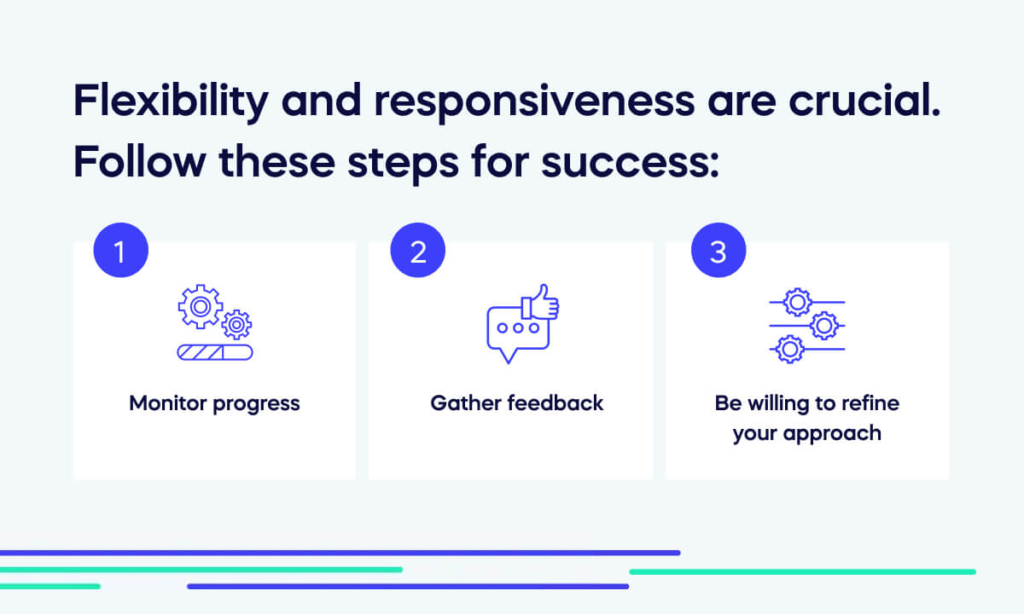
Flexibility and responsiveness are crucial. Follow these steps for success:
- Monitor progress.
- Gather feedback.
- Be willing to refine your approach.
A dynamic strategy allows for real-time adjustments, mitigating unforeseen challenges and ensuring alignment with evolving organizational needs.
Embrace a proactive mindset, treating the change process as iterative, and stay open to strategic modifications for a smoother journey toward successful implementation.
Overcome the 7 common barriers to change with a DAP
The best way to overcome the seven common barriers to change is with the personalized learning that a digital adoption platform (DAP) provides, as it allows you to create in-app content for each change effort.
These features make it easy for staff to understand and integrate new software into their workflow seamlessly, reducing key aspects of resistance to change to achieve desired outcomes as they overcome major barriers to change.
Embrace the power of a DAP not just to overcome barriers but to propel your business into a future of agility and innovation.

